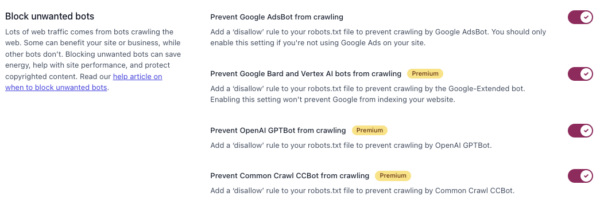AI bots in SEO: To block, or not to block

AI web crawlers like GPTBot, CCBot, and Google-Extended play a significant role in training content for AI models. These bots crawl websites, collect data, and contribute to developing and improving Large Language Models (LLMs) and artificial intelligence. However, many people have asked us the same question: should you block these AI bots in your robots.txt file to protect your content? This article delves into the pros and cons of blocking AI robots and explores the implications.
Taming of the AI bots
This year, there has been a growing debate in our industry about whether to allow or block AI bots from accessing and indexing our content. On the one hand, there are concerns about these bots’ potential misuse or unauthorized scraping of website data. You may worry about using your intellectual property without permission or the risk of compromised sensitive data. Blocking AI web crawlers can be a protective measure to safeguard content and maintain control over its usage.
On the other hand, blocking these bots may have drawbacks. AI models rely heavily on large training data volumes to ensure accurate results. By blocking these crawlers, you might limit the availability of quality training data necessary for developing and improving AI models. Additionally, blocking specific bots may impact the visibility of websites in search results, potentially affecting discoverability. Plus, blocking AI may limit your usage of the tools on your website.
Examples of industries blocking bots
The area is still very new, as search engines are only beginning to give block options. In response to the growing need for content control, Google has introduced Google-Extended, an option for publishers to block the Bard bots from training on their content actively.
This new development comes after receiving feedback from publishers expressing the importance of having greater control over their content. With Google-Extended, you can decide whether your content can be accessed and used for AI training. OpenAI (GPTBot) and Common Crawl (CCBot) are other significant crawlers using robots.txt options. Microsoft Bing uses NOCACHE and NOARCHIVE meta tags to block Bing Chat from training on content.
News publishers
It is worth noting that most major news websites have taken a firm stance. Many publications block these crawlers to safeguard their journalistic work. According to research by Palewire, 47% of the tracked news websites already block AI bots. These reputable establishments understand the importance of protecting their content from unauthorized scraping and potential manipulation.
By blocking AI robots, they ensure the integrity of their reporting, maintaining their status as trusted sources of information. Their collective decision to protect their work highlights the significance of content preservation. The industry needs to find a balance in granting access to AI robots for training.
Ecommerce websites
In ecommerce, another critical consideration arises for site owners. Online retailers with unique product descriptions and other product-related content may strongly desire to block AI bots. These bots have the potential to scrape and replicate their carefully crafted product descriptions. Product content plays a vital role in attracting and engaging customers.
Ecommerce sites invest significant effort in cultivating a distinctive brand identity and compellingly presenting their products. Blocking AI bots is a proactive measure to safeguard their competitive advantage, intellectual property, and overall business success. By preserving their unique content, online stores can better ensure the authenticity and exclusivity of their work.
Implications of (not) blocking AI training bots
As the AI industry evolves and AI models become more sophisticated, you must consider the implications of allowing or blocking AI bots. Determining the right approach involves weighing the benefits of content protection and data security against potential limitations in AI model development and visibility on the web. We’ll explore some pros and cons of blocking AI bots and provide recommendations.
Pros of blocking AI robots
Blocking AI bots from accessing content may have its drawbacks, but there are potential benefits that you should consider:
Protection of intellectual property: You can prevent unauthorized content scraping by blocking AI bots like OpenAI’s GPTBot, CCBot, Google Bard, and others. This helps safeguard your intellectual property and ensures that your hard work and unique creations are not utilized without permission.
Server load optimization: Many robots are crawling your site, each adding a load to the server. So, allowing bots like GPTBot and CCBot adds up. Blocking these bots can save server resources.
Content control: Blocking AI bots gives you complete control over your content and its use. It allows you to dictate who can access and use the content. This helps align it with your desired purpose and context.
Protection from unwanted associations: AI could associate a website’s content with misleading or inappropriate information. Blocking these reduces the risk of such associations, allowing you to maintain the integrity and reputation of your brand.
When deciding what to do with these crawlers, you must carefully weigh the advantages against the drawbacks. Evaluating your specific circumstances, content, and priorities is essential to making an informed decision. You can find an option that aligns with your unique needs and goals by thoroughly examining the pros and cons.
Cons of blocking AI bots
While blocking AI robots may offer particular advantages, it also presents potential drawbacks and considerations. You should carefully evaluate these implications before doing this:
Limiting yourself from using AI models on your website: It is important to focus on the site owner’s perspective and examine how it may impact users. One significant aspect is the potential impact on users relying on AI bots like ChatGPT for personal content generation. For instance, individuals who utilize these to draft their posts may have specific requirements, such as using their unique tone of voice. However, blocking AI robots may constrain their ability to provide the bot with their URLs or content to generate drafts that closely match their desired style. In such cases, the hindrance caused by blocking the bot can significantly outweigh any concerns about training AI models that they may not use directly.
Impact on AI model training: AI models, like large language models (LLMs), rely on vast training data to improve accuracy and capabilities. By blocking AI robots, you limit the availability of valuable data that could contribute to developing and enhancing these models. This could hinder the progress and effectiveness of AI technologies.
Visibility and indexing: AI bots, particularly those associated with search engines, may play a role in website discoverability and visibility. Blocking these bots may impact a site’s visibility in search engine results, potentially resulting in missed opportunities for exposure. For example, take Google’s development of the Search Generative Experience. Although Google said that blocking the Google-Extended crawler does not influence the content in the SGE — just Google Bard — that might change. So, if you block this, it might take your data out of the pool of potential citations that Google uses to generate answers and results.
Limiting collaborative opportunities: Blocking AI robots might prevent potential collaborations with AI researchers or developers interested in using data for legitimate purposes. Collaborations with these stakeholders could lead to valuable insights, improvements, or innovations in AI.
Unintentional blocking: Improperly configuring the robots.txt file to block AI bots could inadvertently exclude legitimate crawlers. This unintended consequence can hinder accurate data tracking and analysis, leading to potential missed opportunities for optimization and improvement.
When considering whether to block AI robots, you must carefully balance content protection and control advantages with the drawbacks mentioned. Evaluating the specific goals, priorities, and requirements of your site and AI strategy is essential.
Did you know?

Learn about generative AI and SEO at Yoast SEO Academy
Want to learn how to adapt SEO content strategies for AI? Looking to gain a competitive advantage by integrating AI tools? Check out our training course on AI for SEO!
So, now what?
Deciding to block or allow AI bots is a challenging decision. It helps if you consider the following recommendations:
Assess specific needs and objectives: Carefully evaluate your site and content’s needs, objectives, and concerns before deciding. Consider factors such as the type of content, its value, and the potential risks or benefits associated with allowing or blocking AI bots.
Explore alternative solutions: Instead of blocking robots outright, consider implementing alternative measures that balance content protection and data availability. For example, rate limiting, user-agent restrictions, or implementing terms of use or API access limitations can help manage AI bot access while still allowing valuable data to be utilized.
Regularly review and update robots.txt: Continuously review your robots.txt file to ensure it aligns with your current strategy and circumstances. Regularly assess the effectiveness of the implemented measures and make adjustments as needed to accommodate changing threats, goals, or partnerships.
Stay informed: Keep updated with industry guidelines, best practices, and legal regulations regarding AI bots and web scraping. Familiarize yourself with relevant policies and ensure compliance with applicable laws or regulations.
Consider collaboration opportunities: While blocking these may have benefits, you can explore potential collaborations with AI researchers, organizations, or developers. Engaging in partnerships can lead to mutually beneficial outcomes. You could exchange knowledge, research insights, or other advancements in the AI field.
Seek professional advice: If you are uncertain about your website’s best course of action, consider asking for help. SEO professionals, legal experts, or AI specialists can help based on your needs and goals.
Blocking AI robots with Yoast SEO Premium
Yoast SEO Premium has a convenient feature that simplifies controlling AI robots. With just a flick of a switch, you can now easily block AI robots like GPTBot, CCBot, and Google-Extended. This automated functionality seamlessly adds a specific line to the robots.txt file, effectively disallowing access to these crawlers.
This streamlined solution empowers you to swiftly and efficiently protect your content from AI bots without requiring manual configuration or complex technical adjustments. Yoast SEO Premium gives you greater control over your content and effortlessly manages your desired crawler access settings by providing a user-friendly option.

Should you block AI robots?
The decision to block or allow AI bots like GPTBot, CCBot, and Google-Extended in the robots.txt file is a complex one that requires careful consideration. Throughout this article, we have explored the pros and cons of blocking these bots. We’ve discussed various factors that you should consider.
On the one hand, blocking these robots can provide advantages such as protection of intellectual property, enhanced data security, and server load optimization. It gives control over your content and privacy and preserves your brand integrity.
On the other hand, blocking AI bots may limit opportunities for AI model training, impact site visibility, and indexing, and hinder potential collaborations with AI researchers and organizations. It requires a careful balance between content protection and data availability.
To make an informed decision, you must assess your specific needs and objectives. Please be sure to explore alternative solutions, stay updated, and consider seeking professional advice when you need it. Remember to regularly review and adjust the robots.txt file based on changes in strategy or circumstances.
Ultimately, blocking or allowing robots should align with your unique goals, priorities, and risk tolerance. It’s important to remember that this decision is not a one-size-fits-all approach. The optimal strategy will vary depending on individual circumstances.
In conclusion, using AI bots in website indexing and training raises important considerations for site owners. You’ll need to evaluate the implications and find the right balance. If so, you’ll find a solution that aligns with your goals, protects your content, and contributes to artificial intelligence’s responsible and ethical development.


Discussion (2)